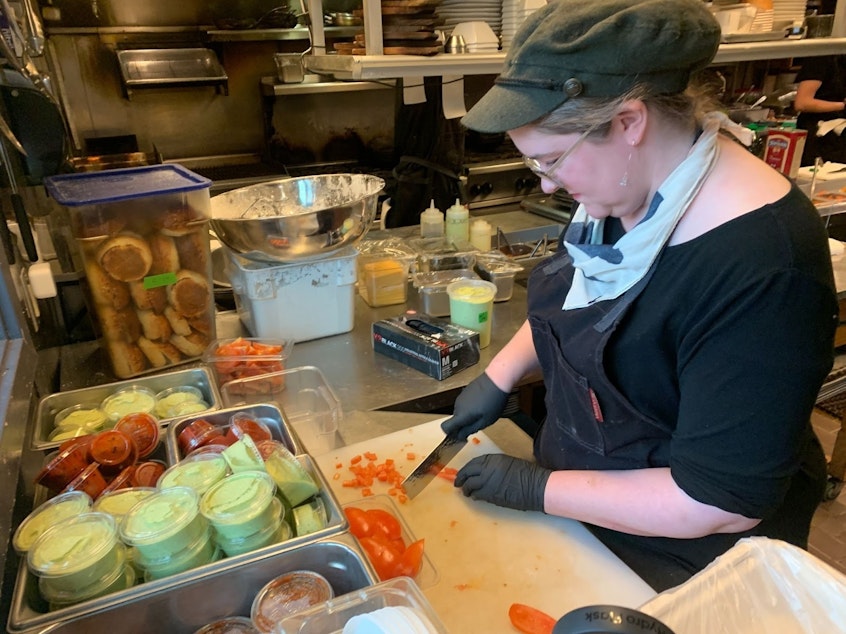A Remote Resort Town Struggles To Find Restaurant Workers For The Summer Season

When dinner service gets into full swing at Jack Sprat, the kitchen and waitstaff hit their groove, making and serving dishes such as roasted beet galette and maple bacon crème brûlée.
But for much of the past year, that wasn't the case inside the small restaurant that sits at the bottom of a ski hill in Girdwood, Alaska.
"When quarantine first happened, there were new rules and new restrictions," says head chef Lindsay Kucera, "but people were expecting the same level of service from us. And we really needed a little grace."
The pandemic shuttered an estimated 110,000 restaurants, either permanently or temporarily, across the United States, according to the National Restaurant Association. Jack Sprat was one of them. Now it has reopened and is having trouble finding enough staff to return to pre-pandemic hours of operation.
The restaurant serves what it describes as "fat and lean world cuisine." You can order Korean bibimbap, a deep sea curry with halibut or a cheeseburger with a zesty poblano aioli. Pandemic lockdowns meant Kucera had to shift from in-restaurant dining to filling takeout orders.
Sponsored
"We were changing what was casual, fine dining in house [and] doing delivery suddenly," Kucera says.
The takeout model meant menu items like the bibimbap were put on hold. Cheeseburgers and signature sweet potato fries were delivered to customers in foam boxes. Still, to-go orders didn't make up for the revenue lost from in-house dining.
Demand for Jack Sprat's fare remained, but the staff did not. According to owners Jennifer and Frans Weits, many servers and cooks disappeared during the pandemic. Pre-COVID-19, they had 38 employees. Today, they have just 22. Other restaurants in the area had similar problems.
"It's really great to see a team coming together and working to make the same amount of stuff happen with less resources," says Kucera, "but ultimately, it's exhausting. We are all so tired."
She says she knows many people in the industry who didn't like the instability laid bare by pandemic-related restrictions. Many opted to pursue other work.
Sponsored
"Working in a restaurant is not the easiest thing to do," says Ginger Patak. "People treat servers, like, not very good, sometimes."
Patak waited tables for years until she was laid off from a restaurant run by Girdwood's local ski resort in March of 2020 as the pandemic was beginning to shutter many businesses.
The layoff allowed her to volunteer at the local fire department. She spent hundreds of hours doing so over the past year.
"So, for me, the fire department came just at the perfect time," she says.
It helped her realize she was tired of relying on minimum wage and the tips from serving.
Sponsored
"When COVID happened, that really put everything into perspective for a lot of people," she says. The pandemic prompted her to look for what she describes as more reliable and fulfilling work. She found it through an emergency medical technician (EMT) certification program.
"Once I was here for a few months," Patak says, "I was like, 'Yeah, no, forget the restaurants.' "
Now she's aiming for paramedic school.
According to the National Restaurant Association, hiring is recovering. Restaurants added 187,000 jobs in April, but the total number of restaurant workers is still 14% below pre-pandemic levels.
"Before the pandemic we were open [for] three lunches and seven nights a week," says Jack Sprat owner Frans Weits, whose restaurant has been open for 20 years.
Sponsored
"Now, we're open five nights a week. So, we were at 10 shifts, now we're at five shifts."
He says there's demand from diners but not enough workers to serve them.
Co-owner Jennifer Weits says it's hard to watch cars pull into their parking lot on nights the restaurant is closed.
To lure potential employees, the Weitses offer at least $15 an hour to experienced staff. That's roughly $3 higher than the U.S. average, according to the Bureau of Labor Statistics.
Jack Sprat has also implemented a new policy so that tips are shared between waitstaff and kitchen staff.
Sponsored
"It's on average about $30 an hour," Frans says.
Jen says this change has also improved staff culture. "I've noticed less of an us versus them, front of house [versus] back of the house," she says, "which is sort of cliché in the industry."
The Weitses have also taken on other problems made worse by COVID-19.
Housing is a big issue, especially in a place like Alaska where it's both expensive and limited. So in addition to paying staff more, the Weitses say they feel pressure to provide workers with a place to live.
They've rented a four-bedroom house to help attract servers to the town about an hour south of Anchorage.
They've also considered buying property but decided to put that idea on hold for now.
"It'd take a lot of our personal retirement and funds to do that," Jen says.
With the summer hiking and camping season now in full swing in Alaska and people feeling safer to travel given vaccinations and low COVID-19 infection rates, the Weits expect wave upon wave of tourists.
But they're still worried that despite what they're offering potential employees, it won't be enough to help feed all those hungry guests who pull into Jack Sprat's parking lot. [Copyright 2021 NPR]


